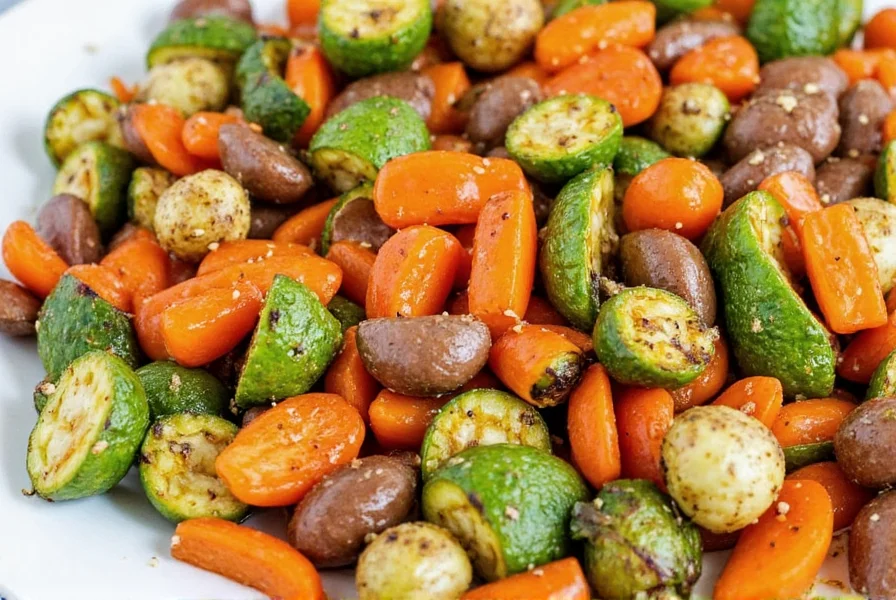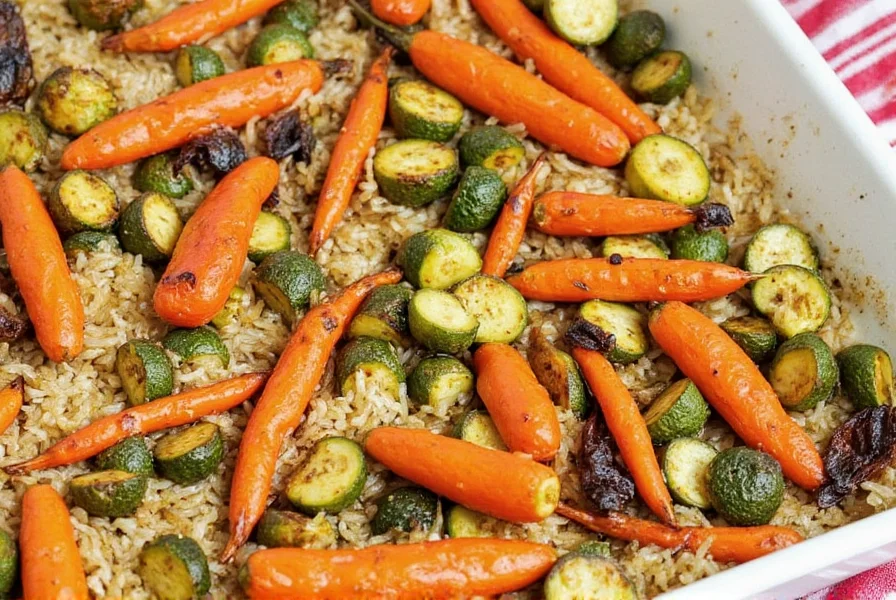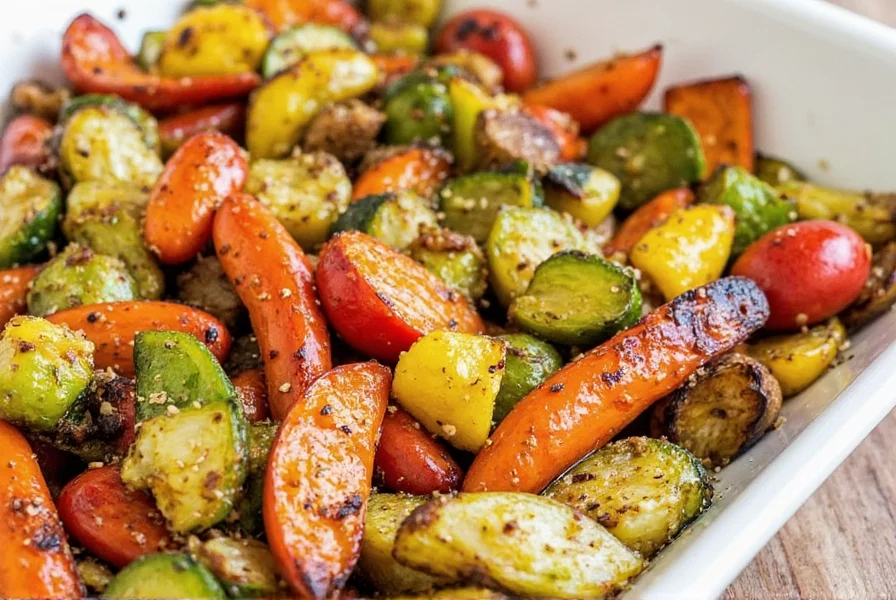Roasting vegetables is a culinary superpower—crispy edges, tender centers, and that magical caramelization everyone loves. But what really makes roasted veggies shine isn't just the roasting technique—it's the seasoning. Whether you're a home cook or a pro chef, this guide will give you the tools to unlock flavor like never before.
| Blend Name | Main Flavors | Best For | Heat Level |
|---|---|---|---|
| Mediterranean Magic | Herby, citrusy | Zucchini, eggplant, bell peppers | Low |
| Smoky Southwestern | Smoky, earthy | Squash, corn, onions | Medium |
| Herb Heaven | Earthy, aromatic | Potatoes, carrots, cauliflower | Low |
| Asian-Inspired Umami | Savory, spicy | Broccoli, bok choy, mushrooms | Medium-High |
| Indian Twist | Warm, rich | Brussels sprouts, potatoes, chickpeas | Low-Medium |
| Vegetable | Recommended Spices | Flavor Profile |
|---|---|---|
| Carrots | Cumin, cinnamon, paprika | Earthy + sweet |
| Broccoli | Garlic powder, soy sauce, sesame oil | Umami + savory |
| Brussels Sprouts | Balsamic vinegar, maple syrup, smoked paprika | Tangy + smoky |
| Squash | Nutmeg, cinnamon, sage | Warm + cozy |
| Asparagus | Lemon zest, Parmesan, garlic | Crisp + fresh |
| Onions | Thyme, balsamic glaze, brown sugar | Sweet + tangy |
| Cauliflower | Cumin, turmeric, garam masala | Spiced + hearty |
| Name | Features | Best For | Pros | Cons |
|---|---|---|---|---|
| Simply Organic Mediterranean Herb Blend | Organic herbs including marjoram, thyme, rosemary | Tomatoes, eggplant, zucchini | All-natural, versatile, fragrant | Pricey compared to homemade |
| Badia Latin Seasoning | Pepper, garlic, oregano, cumin | Plantains, squash, corn | Affordable, bold flavor | Contains anti-caking agents |
| Spice Islands Italian Seasoning | Thyme, basil, oregano, marjoram | Potatoes, peppers, eggplant | Classic taste, perfect for beginners | May be too mild for adventurous palates |
| Trader Joe's Everything But the Bagel Seasoning | Poppy seeds, sesame seeds, garlic, onion, salt | Broccoli, cauliflower, Brussels sprouts | Cheesy texture, unique twist | High sodium content |
| Rub Me Right Smoked BBQ Rub | Smoked paprika, molasses, brown sugar, garlic | Root veggies, onions, squash | Deep flavor, caramelizes beautifully | Overpowers delicate veggies |
Why Seasoning Matters
We often forget how much seasoning impacts flavor. While roasting brings out natural sweetness, the right spices elevate it into something unforgettable. Think about it—plain carrots vs. carrots roasted with smoked paprika and honey. One's lunch. The other's a memory.

Basic Ingredients Every Veggie Lover Needs
Before diving into fancy blends, here are the staples every pantry should have:
- Olive oil (or avocado oil)
- Kosher salt
- Freshly ground black pepper
- Garlic powder
- Dried herbs (like thyme, rosemary, oregano)
- Paprika (sweet, smoked, or hot)
- Lemon zest or juice
Top 10 Seasoning Blends for Roasted Veggies
Mix your own magic with these easy-to-make seasoning combos that turn any vegetable into a star.
- Mediterranean Magic: Oregano, garlic powder, lemon zest, olive oil, salt
- Smoky Southwestern: Smoked paprika, cumin, chili powder, lime zest, cilantro
- Herb Heaven: Rosemary, thyme, garlic, salt, black pepper, olive oil
- Asian-Inspired Umami: Soy sauce, sesame oil, ginger, garlic powder, crushed red pepper
- Indian Twist: Garam masala, turmeric, coriander, cumin, curry leaves (optional)
- Sweet Heat Blend: Brown sugar, smoked paprika, cayenne, garlic powder
- Italian Classic: Basil, oregano, garlic powder, onion powder, Parmesan (optional)
- Cajun Kick: Cayenne, paprika, garlic powder, onion powder, dried thyme
- Lemony Dill: Lemon zest, dill, garlic powder, salt, olive oil
- Curry Comfort: Curry powder, turmeric, cumin, coconut oil


How to Apply Seasoning Like a Pro
You've got your veggies chopped and your tray lined. Now comes the magic touch—seasoning. Here's how to do it right:
- Preheat your oven to 400°F (200°C) for best caramelization.
- Use enough oil — around 2–3 tbsp per baking sheet helps flavors stick and promotes crispiness.
- Season before roasting — Toss everything together so the flavor seeps in as they roast.
- Add fresh herbs after roasting — basil or cilantro can lose potency if added too early.
- Drizzle sauces post-bake — things like tahini, hot sauce, or aioli add depth without burning.
- Don't overcrowd the pan — give space for air to circulate and create those crispy edges.

Buying Guide: What to Look For in Seasonings
If making your own blends feels overwhelming, no worries—you can buy premixed seasonings. Just be sure to choose wisely. Here's what to look for:
- Minimal ingredients: Avoid additives like MSG or fillers unless they're clearly labeled as natural.
- Whole spices vs. ground: Whole spices (like cumin seeds) last longer and grind fresh for better flavor.
- Check expiration dates: Spices don't spoil but they do lose potency over time.
- Organic options: If purity is important, go for USDA Organic-certified blends.
- Storage matters: Keep seasonings in airtight containers away from light and heat.

Frequently Asked Questions
Common Questions About Seasoning Roasted Vegetables
When should I add seasoning to my roasted vegetables?
Season your vegetables before roasting by tossing them with oil and seasonings. This allows the flavors to penetrate as they roast. Add fresh herbs and finishing sauces like tahini or aioli after roasting to preserve their flavor and prevent burning. As mentioned in the "How to Apply Seasoning Like a Pro" section, proper timing makes all the difference in flavor development.
How much seasoning should I use for roasted vegetables?
A good rule of thumb is 1-2 teaspoons of dry seasoning per pound of vegetables. Start with less—you can always add more after roasting. Remember that flavors concentrate as vegetables roast, so it's better to under-season slightly and adjust at the end. For oil-based dressings, use about 2-3 tablespoons per baking sheet to help the seasonings adhere properly.
Can I use fresh herbs instead of dried ones for roasting?
Yes, but with caution. Fresh herbs like rosemary or thyme can be used, but they're best added halfway through roasting or at the end to prevent burning. Dried herbs are more concentrated and better suited for the entire roasting process. As a general rule, use 3 times more fresh herbs than dried since dried herbs are more potent. The article's "How to Apply Seasoning Like a Pro" section recommends adding fresh herbs after roasting for maximum flavor impact.
What oil is best to use when roasting vegetables?
Olive oil and avocado oil are excellent choices for roasting vegetables. They have high smoke points and help create crispy edges while carrying flavor. Use about 2-3 tablespoons per baking sheet. For Asian-inspired dishes, sesame oil (used sparingly with a neutral oil) adds great flavor. For Indian-style roasting, coconut oil works beautifully with curry spices. The "Basic Ingredients" section highlights these essential oils for any veggie lover's pantry.
Why are my roasted vegetables not getting crispy?
Several factors could be at play: 1) Your oven temperature might be too low (aim for 400°F/200°C), 2) You might be using too much oil, 3) The vegetables could be overcrowded on the pan (leave space between pieces), or 4) The vegetables might have high water content that's steaming instead of roasting. Try spreading them in a single layer with space between pieces for best results. The "How to Apply Seasoning Like a Pro" section specifically mentions not overcrowding the pan as essential for creating crispy edges.
Can I use the same seasoning for all vegetables?
While some versatile blends like garlic-herb or basic salt-pepper-oil work well across many vegetables, different veggies have unique flavor profiles that pair better with specific seasonings. Root vegetables like carrots and potatoes handle bolder spices, while delicate vegetables like asparagus pair better with lighter seasonings. Refer to the vegetable & spice pairing guide in this article for best results. The comprehensive pairing chart provides specific recommendations for seven common vegetables.
How should I store homemade seasoning blends?
Store homemade seasoning blends in airtight containers away from light and heat. Glass jars with tight-fitting lids work well. Properly stored, most dry seasoning blends will maintain their potency for 6-12 months. Label your containers with the date you made them so you can track freshness. The "Buying Guide" section emphasizes that proper storage is crucial for maintaining seasoning potency over time.
Do I need to add salt before or after roasting?
For best results, add salt before roasting. This helps draw out moisture from the vegetables, which promotes caramelization and allows the seasoning to penetrate. Use kosher salt as it adheres well and has a clean flavor. You can always add a finishing salt after roasting for extra texture and flavor, but the base seasoning should happen before they go in the oven. The "How to Apply Seasoning Like a Pro" section specifically recommends seasoning before roasting so "the flavor seeps in as they roast."
What are the most versatile seasoning blends for beginners?
The most versatile starter blends are: 1) Mediterranean Magic (oregano, garlic powder, lemon zest), 2) Herb Heaven (rosemary, thyme, garlic), and 3) Simple Italian (basil, oregano, garlic powder). These work well with most vegetables and can be easily customized as you develop your seasoning skills. The "Top 10 Seasoning Blends" section details these and other excellent options for various flavor profiles.
Can I use citrus with roasted vegetables without making them soggy?
Yes, but timing is key. Add citrus zest before roasting as it contains oils that won't add moisture. Reserve citrus juice until after roasting to prevent steaming instead of roasting. If you want citrus flavor throughout the roasting process, reduce the juice to a syrup first, which concentrates the flavor without excess moisture. Several of the recommended blends, like Mediterranean Magic and Lemony Dill, incorporate citrus elements effectively.
Final Thoughts
Seasoning for roasted veggies is more than just sprinkling salt and pepper. It's about crafting layers of flavor, creating memorable meals, and enjoying the process. Whether you mix your own blends or opt for pre-made ones, the key is to experiment and have fun with it.
So next time you're tossing some veggies in the oven, don't settle for "just okay." Make them pop with the right blend of spice and love. Your tastebuds—and your dinner guests—will thank you.












 浙公网安备
33010002000092号
浙公网安备
33010002000092号 浙B2-20120091-4
浙B2-20120091-4